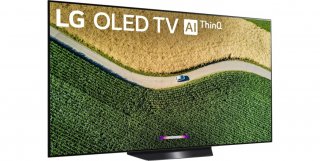Get Ready, Samsung: OLED May Have a New Way to Crush QLED HDTVs
Researchers at the Paul Scherrer Institute in Switzerland have discovered a new organic light-emitting diode (OLED) material that could improve upon current technologies and be relatively inexpensive to produce on a large scale.
Researchers at the Paul Scherrer Institute in Switzerland have discovered a new organic light-emitting diode (OLED) material that could improve upon current technologies and be relatively inexpensive to produce on a large scale.
These enticing results come from a new arrangement of copper electrons, CuPCP, which would replace the more expensive precious metal diodes, PHOLEDs.
OLEDs are the natural offspring of light-emitting diode (LED) technology. About a decade ago, it was often Plasma vs. LED in the cutthroat TV world, and more often than not, Plasma came out on top. But the shortcoming of Plasma TVs was that they generally only worked for larger-size panels, while LEDs suffered from poor picture quality stemming from lackluster black levels and contrast ratio.
Then OLED TVs took the stage and improved upon both technologies. Today, as we can see with LG’s wildly popular OLED offerings, these TVs utilize self-emissive pixels, jettisoning the need for backlighting and allowing for a much thinner design. When electricity passes through these pixels, which number in the millions in these TVs, they light up in different colors.
The other advantage is that there are no longer dark pixels being lit from behind. When OLED pixels can remain completely dark, the black color on your screen is basically 100 percent true. OLED TVs also use additional white light to manufacture even more varied colors, which make for images that are more diverse, richer and more accurate. Moreover, OLED TVs are more environmentally friendly because they use less energy than their counterparts that depend on energy-guzzling backlighting.
For all of these positives, however, researchers have found it rather difficult to scale OLEDs for wider usage. OLEDs are restricted by the naturally occurring limitations of their fluorescence. PHOLEDS are much more efficient, but they require highly expensive precious metals like iridium, ruthenium and platinum—costs that would eventually be passed down to consumers.
Researchers at the Paul Scherrer Institute have now succeeded in making a more precise examination of the copper-containing compound CuPCP. According to the study, copper is a relatively inexpensive metal, and the compound itself can be easily produced in large quantities.
After using high-tech instruments to take a closer look at the short-lived excited states of the copper compound, the research team concluded that the substance’s chemical structure would be a solid candidate for OLEDs. The compound’s quantum chemical properties indeed made it possible to achieve high light yields.
Researchers noted that the data gathered will surely help drive forward future OLED technologies.
“So in the future, it will be possible to better predict which compounds are more suitable for OLEDs and which less,” physicist Grigory Smolentsev said in a release. “The measurement data will help the chemists understand which part of the molecule stands in the way of high efficiency. And of course, how the compound can be improved to increase its light output.”
The study’s findings were reported in the journal Nature Communications.
Ethen Kim Lieser is a Tech Editor who has held posts at Google, The Korea Herald, Lincoln Journal Star, AsianWeek and Arirang TV. He currently resides in Minneapolis.

